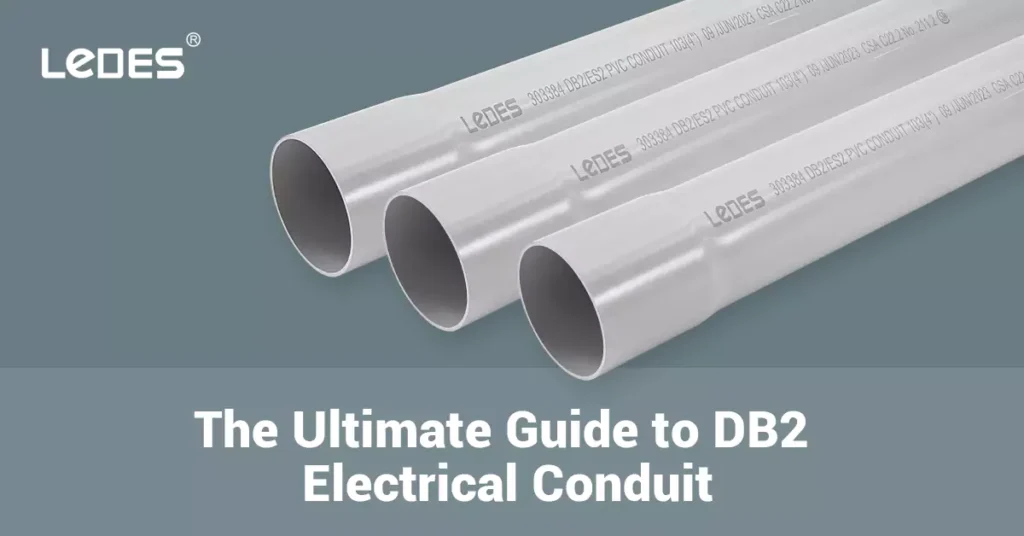
Inhaltsverzeichnis
Was ist ein DB-Conduit?
DB-Rohre, auch als Direct Burial-Rohre bekannt, sind Rohre, die speziell für den Schutz und die unterirdische Verlegung von elektrischen Kabeln und Leitungen entwickelt wurden. Sie sind eine wichtige Komponente in verschiedenen Bau- und Versorgungsprojekten und dienen als Schutzweg oder -hülle für die Verlegung von elektrischen Kabeln und Leitungen unter der Erdoberfläche. DB-Versorgungsrohre werden aus Materialien hergestellt, die Haltbarkeit und Widerstandsfähigkeit gegen Umwelteinflüsse, Feuchtigkeit und physische Schäden bieten.
DB-Rohre bestehen normalerweise aus starrem Polyvinylchlorid (PVC) und sind in verschiedenen Durchmessern und Wandstärken erhältlich. Das „DB“ im Namen steht für „Direct Burial“ (direkte Verlegung) und weist darauf hin, dass sie für die unterirdische Verlegung geeignet sind, ohne dass eine zusätzliche Betonummantelung erforderlich ist. Dies macht sie zu einer kostengünstigen und vielseitigen Option für verschiedene unterirdische elektrische Anwendungen.
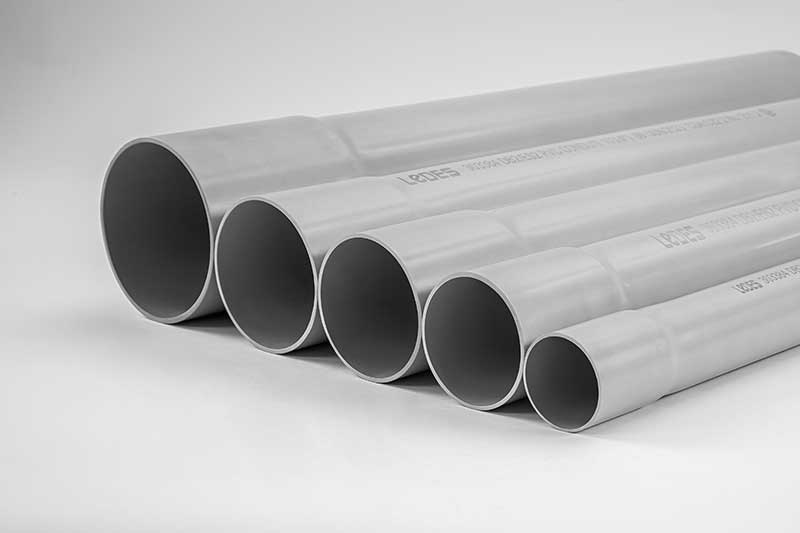
Arten von DB-Leitungen
Es sind mehrere Arten von DB-Leitungen erhältlich, jede mit ihren eigenen Spezifikationen und Vorteilen. Hier sind einige der gängigsten:
DB60 Versorgungskanal:
Der DB60-Versorgungskanal ist ein speziell für die Aufnahme von Kabeln und Leitungen in Telekommunikations- und Datennetzwerkanwendungen entwickelter Kanaltyp. Die Bezeichnung „DB60“ bezieht sich auf seine Abmessungen, wobei die Standardgröße in Höhe und Breite 60 mm beträgt. Es ist jedoch wichtig zu beachten, dass möglicherweise andere Größen und Varianten verfügbar sind, um bestimmten Installationsanforderungen gerecht zu werden.
Vorteile:
- Mühelose Installation: Verabschieden Sie sich von schweren Betonummantelungen. Die Möglichkeit der direkten Verlegung des DB60 in die Erde spart Ihnen Zeit und Geld und macht die Installation zum Kinderspiel.
- Überlegene Stärke: DB60 ist so konstruiert, dass es dem Druck des unterirdischen Bodens und den Belastungen durch Bewegungen standhält und so dafür sorgt, dass Ihre Kabel sicher bleiben.
- Kostengünstige Wahl: Im Vergleich zu herkömmlichen Metallrohren bietet DB60 dank seiner einfachen Installation und seines geringeren Gewichts erhebliche Kosteneinsparungen.
Erforderliche Vergrabungstiefe:
Allgemeine Richtlinie für Mindestverlegetiefen basierend auf Leitungstyp und Standort (spezifische Anforderungen finden Sie im National Electrical Code (NEC) und anderen Industrienormen):
- Wohngebiete: 18 Zoll (45 cm)
- Gewerbe- und Industriebereiche: 24 Zoll (60 cm)
- Straßenübergänge: 36 Zoll (90 cm)
Industriestandard:
Der DB60-Versorgungskanal ist nicht nur auf Langlebigkeit ausgelegt, sondern entspricht auch den höchsten Standards. Er erfüllt strenge Branchenvorschriften wie NEMA TC-6 und TC-8 für Versorgungskanäle sowie ASTM F-512 und stellt sicher, dass Ihr Projekt alle erforderlichen Sicherheits- und Leistungsanforderungen erfüllt.
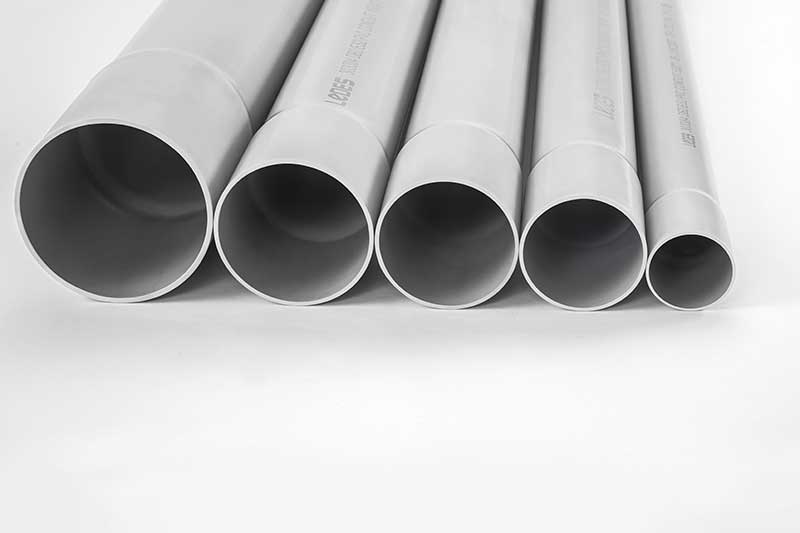
DB120-Leitung
Was ist ein DB120-Conduit?
DB120-Rohre sind elektrische Rohre, die häufig zum Schutz und zur Organisation elektrischer Drähte und Kabel verwendet werden. Sie bestehen aus hochwertigen, langlebigen Materialien wie Polyvinylchlorid (PVC) oder Polyethylen (PE), die eine hervorragende Beständigkeit gegen Korrosion, Feuchtigkeit, Chemikalien und UV-Strahlen bieten. Die Bezeichnung „DB120“ bezieht sich auf die spezifische Einstufung des PVC, die seine Wandstärke und Festigkeit angibt.
Vorteile:
- Haltbarkeit: Das DB120-Rohr ist korrosions-, chemikalien- und witterungsbeständig und daher ideal für den langfristigen Einsatz unter der Erde geeignet.
- Schlagfestigkeit: Die dicken Wände des DB120-Rohrs halten erheblichen Stößen stand und schützen die Kabel im Inneren vor Beschädigungen.
- Geringes Gewicht: Im Vergleich zu Beton- oder Metallrohren ist DB120 viel leichter und daher einfacher zu handhaben und zu installieren.
- Flexibilität: DB120-Rohre sind in verschiedenen Längen und Durchmessern erhältlich und lassen sich daher leicht an unterschiedliche Projektanforderungen anpassen.
- Kostengünstig: DB120-Rohre sind im Vergleich zu anderen Arten von unterirdischen Rohren eine relativ kostengünstige Option.
Erforderliche Vergrabungstiefe:
- Wohngebiete: 12 Zoll (30 cm)
- Gewerbe- und Industrieflächen: 18 Zoll (45 cm)
- Straßenübergänge: 36 Zoll (90 cm)
Normen für DB120-Rohre:
DB120-Rohre müssen mehrere Industrienormen erfüllen, um ihre Qualität und Sicherheit zu gewährleisten. Zu diesen Normen gehören:
ASTM F-512: Standard-Spezifikation für glattwandige Polyvinylchlorid-(PVC)-Leitungen, Leitungsverbindungen und Muffeneinsätze
NEMA TC-6: Leitungen und Armaturen aus Polyvinylchlorid (PVC) für den unterirdischen Einsatz
NEMA TC-8: Nichtmetallischer unterirdischer Versorgungskanal
Installation:
Die Installation von DB120-Leitungen ist relativ unkompliziert. Hier sind die grundlegenden Schritte:
- Einen Graben ausheben: Der Graben sollte tief genug sein, um den örtlichen Anforderungen für die Verlegetiefe von Strom- und Kommunikationsleitungen zu entsprechen.
- Verlegen Sie das Rohr: Platzieren Sie das Rohr im Graben und stellen Sie sicher, dass es eben und frei von Ablagerungen ist.
- Verbinden Sie die Leitungsabschnitte: Verwenden Sie Lösungsmittelkleber oder mechanische Kupplungen, um die Leitungsabschnitte miteinander zu verbinden.
- Ziehen Sie die Kabel: Ziehen Sie die Elektro- oder Kommunikationskabel durch das Kabelrohr.
- Graben wieder auffüllen: Füllen Sie den Graben wieder mit Erde auf und stampfen Sie diese fest, um Lufteinschlüsse zu vermeiden.
Anwendungen:
DB120-Rohre werden in zahlreichen Anwendungen eingesetzt, darunter:
- Unterirdische elektrische Verkabelung in Wohn- und Geschäftsgebäuden
- Ampel- und Straßenbeleuchtungssysteme
- Telekommunikations- und Datenkabel
Rohr Typ EB20/35
Was sind Leitungen vom Typ EB20/35?
Diese aus robustem PVC (Polyvinylchlorid) gefertigten Leitungen sind speziell für die Verlegung in Beton vorgesehen. Dadurch werden sie zu einem integralen Bestandteil der unterirdischen Infrastruktur und schützen empfindliche elektrische Kabel vor den harten Bedingungen des Lebens unter der Erde.
Vorteile:
- Außergewöhnliche Stärke: Die Bezeichnung „EB“ steht für ihre außergewöhnliche Stoßfestigkeit, die dem Druck von Bodenverschiebungen und versehentlichen Stößen standhält. Betrachten Sie sie als stille Wächter, die dafür sorgen, dass Ihr elektrischer Strom ohne Unterbrechung fließt.
- Überragende Haltbarkeit: Einbetoniert bilden diese Leitungen ein robustes und stabiles Netzwerk, das das Risiko von Schäden durch Bodenbewegungen minimiert und eine lang anhaltende Leistung gewährleistet.
- Geringes Gewicht: Im Vergleich zu ihren Gegenstücken aus Metall sind EB20/35-Rohre federleicht und daher einfacher zu handhaben und zu installieren, was Zeit und Arbeitskosten spart.
- Kompatibilität: Diese Leitungen sind in verschiedenen Durchmessern und Längen erhältlich und können an die unterschiedlichsten Projektanforderungen angepasst werden, von kleinen Wohninstallationen bis hin zu weitläufigen Gewerbekomplexen.
Normen:
Um ihre Qualität und Sicherheit zu gewährleisten, müssen EB20/35-Rohre den strengen Industriestandards ASTM F-512 und NEMA TC-6 entsprechen.
Installation:
Die Installation des EB20/35-Rohrs erfolgt unkompliziert:
- Grabenkrieg: Graben Sie einen Graben, der tief genug ist, um den örtlichen Anforderungen an die Vergrabungstiefe zu entsprechen und der den darin liegenden elektrischen Leitungen ausreichend Schutz bietet.
- Betonhalterung: Bereiten Sie ein Bett aus stabilem Beton vor, das als stützende und schützende Ummantelung für die Leitung dient.
- Legen des Fundaments: Platzieren Sie die Leitungsabschnitte vorsichtig im Graben und achten Sie dabei auf die richtige Ausrichtung und Verbindung.
- Kräfte vereinen: Verwenden Sie Lösungsmittelkleber oder mechanische Kupplungen, um ein nahtloses und auslaufsicheres Leitungsnetz zu schaffen.
- Betonummantelung: Bedecken Sie die Leitung mit dem vorbereiteten Beton und schaffen Sie so einen einheitlichen und undurchdringlichen Schild.
DB2/ES2 PVC-Kanal
Was ist ein DB2/ES2-PVC-Kanal?
Der DB2/ES2-Kanal ist ein starres Rohr aus Polyvinylchlorid (PVC), das speziell für die direkte Erdverlegung und für betonummantelte Anwendungen entwickelt wurde.
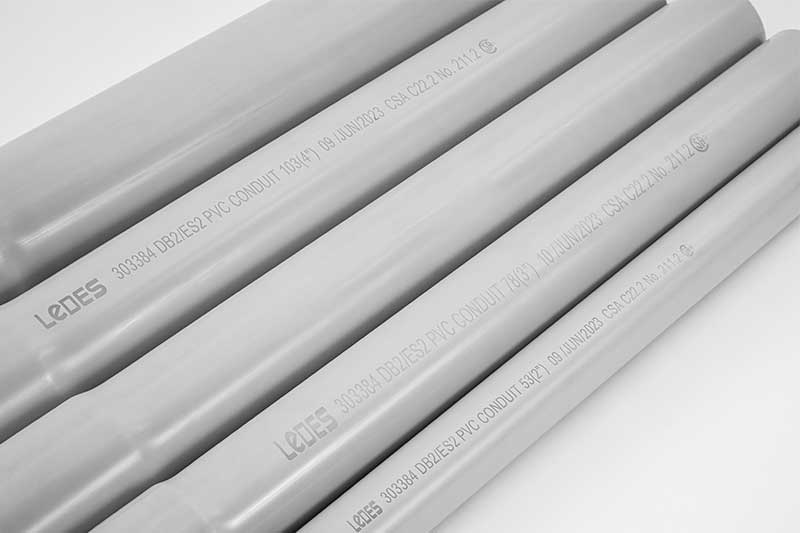
Vorteile:
- Korrosionsbeständig: DB2/ES2 PVC-Rohre bestehen aus hochwertigem PVC-Material, sind nicht metallisch und rosten selbst unter natürlichen Korrosionsbedingungen nicht. Sie gewährleisten eine langfristige Leistung im Untergrund und bieten sicheren und zuverlässigen Schutz für Verkabelungssysteme.
- Geringes Gewicht: Das geringe Gewicht erleichtert die Handhabung und Installation und spart erheblich Zeit und Arbeitskosten.
- Direkte Vergrabung: Für die direkte Vergrabung vorgesehen und erfordert keinen zusätzlichen Schutz, wenn die Installation gemäß dem Canadian Electrical Code (CEC) erfolgt.
- Einfaches Ziehen von Drähten: Die glatte Innenfläche des DB2/ES2 verringert die Reibung beim Ziehen von Drähten und Kabeln über lange Strecken.
Normen:
CSA C22.2 Nr. 211.1 (Kanada): Diese wichtige Norm gilt für starre PVC-Rohre für unterirdische Elektroinstallationen in Kanada und garantiert die Einhaltung der örtlichen Vorschriften und Sicherheitsanforderungen.
Gemäß CSA C22.2 Nr. 211.1 erforderliche Leistung:
- Schlagfestigkeit: Es bietet hohe Schlagfestigkeit auch bei kaltem Wetter. CSA C22.2 Nr. 211.1 erfordert, dass der Kanal den Schlagtest bei -18 °C besteht und keine Risse oder Spalten an der Innen- oder Außenseite des Kanals aufweist.
- Druckfestigkeit: Die Norm schreibt vor, dass die prozentuale Durchmesserabnahme bei DB2/ES2 unter Last 10% und nach der Rückverformung 5% nicht überschreiten darf.
- Steifigkeit: Die Norm erfordert, dass die Leitung eine Mindestrohrsteifigkeit von 300 kPa bei 5%-Durchbiegung aufweist.
Schneiden und Fügen:
DB2/ES2-PVC-Rohre können problemlos mit einer Metallsäge zugeschnitten werden. Für kleine Größen können Sie auch einen PVC-Schneider verwenden.
Zum Verbinden der Leitungs- oder Formstücklängen ist lediglich Lösemittelkleber erforderlich. PVC-Lösemittelkleber kann die Verbindungen stabil und dicht machen. Einfache Handhabung und Zeitersparnis.
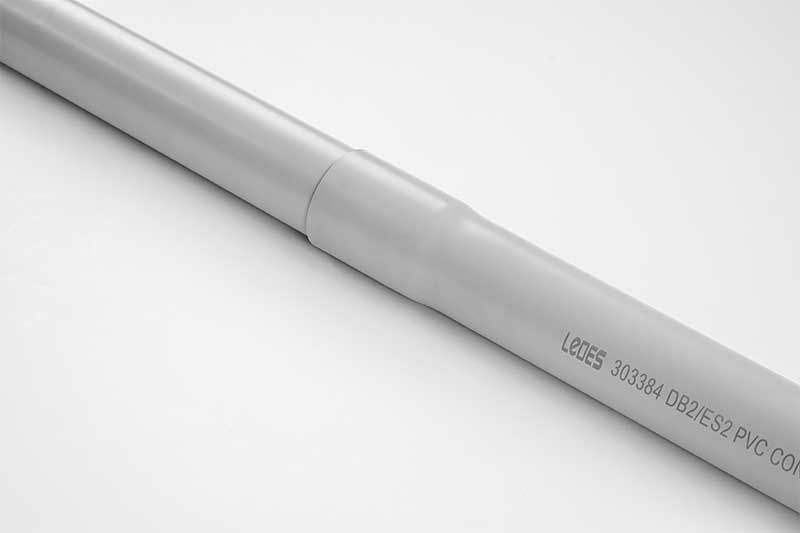
Installation:
- Grabenboden: Graben Sie einen Graben, der tief genug ist, um die örtlichen Anforderungen an die Vergrabungstiefe zu erfüllen und die darin befindlichen Stromleitungen zu schützen.
- Legen des Fundaments: Platzieren Sie die DB2-Kanalabschnitte vorsichtig im Graben und achten Sie dabei auf die richtige Ausrichtung und Verbindung mithilfe von Lösungsmittelkleber oder mechanischen Kupplungen.
- Verfüllen: Sobald die Leitung sicher ist, füllen Sie den Graben mit Erde auf. Achten Sie dabei auf die richtige Verdichtung, um Lufteinschlüsse zu vermeiden.
Möglicherweise haben Sie folgende Fragen:
Welcher Kanal ist der richtige für mein Projekt?
Die Wahl des richtigen Kanals hängt von Ihren spezifischen Anforderungen ab:
- Für unterirdische Installationen ohne Betonummantelung: Wählen Sie DB120 aufgrund seiner überlegenen Festigkeit und Haltbarkeit.
- Für oberirdische oder betonierte Installationen: DB2 ist eine kostengünstige Option zum Schutz von Kabeln in Wänden, Decken und freiliegenden Leitungen.
- Für stark frequentierte Bereiche oder Anwendungen, die zusätzlichen Schutz erfordern: Aufgrund seiner robusten Konstruktion ist der DB120 auch für oberirdische Installationen geeignet.
Gibt es weitere Faktoren, die berücksichtigt werden müssen?
- Lokale Bauvorschriften: Überprüfen Sie immer die lokalen Vorschriften bezüglich der Art und Installation von Elektroleitungen und halten Sie diese ein.
- Temperaturbeschränkungen: Für beide Kanäle gelten empfohlene Temperaturbereiche. Stellen Sie daher sicher, dass Ihre Anwendung innerhalb dieser Grenzen liegt.
- Zukünftiger Erweiterungsbedarf: Wenn Sie mit einer zukünftigen Erweiterung Ihres elektrischen Systems rechnen, wählen Sie eine Kanalgröße, die zusätzliche Verkabelung aufnehmen kann.
Denken Sie daran: Für eine spezifische Projektberatung und die Gewährleistung einer sicheren und konformen Installation wird stets die Beratung durch einen qualifizierten Elektriker oder Bauunternehmer empfohlen.
Kontakt
Wenn Sie Fragen haben, wenden Sie sich bitte an Senden Sie hier das Kontaktformular oder E-Mailen Sie uns noch heute.



